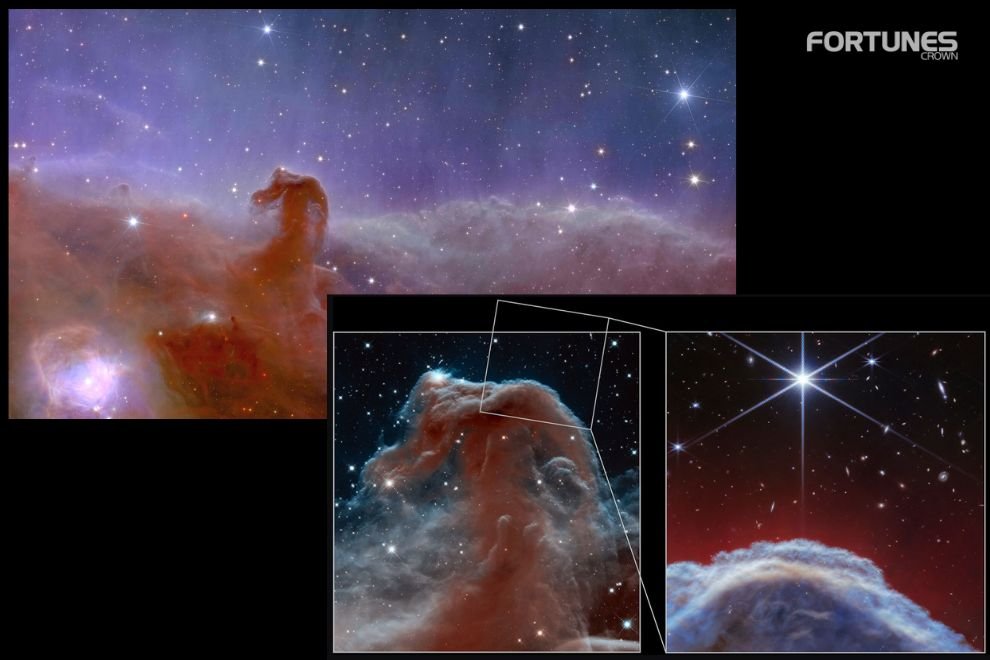Integrating science into our daily lives has deepened our understanding of the cosmos. It spans from the infinitesimal realms of atomic particles to the grand expanse of the universe itself. Moreover, this integration has led to remarkable discoveries and technological advancements. Despite the remarkable steps we’ve made in unveiling the mysteries of existence, the universe remains an inexhaustible spring of discovery. It tempts us to delve deeper into its depths, offering tantalizing prospects for further exploration and understanding.
Here’s one such space marvel that has intrigued NASA’s attention and has presented itself with a great grandeur that has been captured in the James Webb Telescope’s capture.
About The Star
The Horsehead Nebula, also called Barnard 33, is a dark patch in the sky in
the constellation Orion. It has been a part of a bigger group of stars and clouds called the Orion complex. It can be found just below the star Alnitak, which is the easternmost star in Orion’s Belt.
A Scottish astronomer named Williamina Fleming first spotted it in 1888, in a photo taken at the Harvard College Observatory. Even though it’s about 1500 light years away from Earth, it’s famous because of its unique shape that resembles something that is seen on Earth, that is, it looks like the profile of a horse’s head.
NASA’s James Webb Telescope’s capture
The Telescope has finally unveiled the sharpest infrared images ever captured of a focused segment of the Horsehead Nebula. This achievement offers a unique perspective on this iconic cosmic structure, providing new insights into its composition and dynamics.
The latest images zoom in on a portion of the sky within the constellation Orion (The Hunter), situated on the western side of the Orion B molecular cloud. Here, amidst swirling clouds of dust and gas, the Star, also known as Barnard 33, emerges approximately 1,300 light-years away.
An interstellar cloud gravitationally collapsed to create the Star fueled by the radiant energy of a nearby hot star. While surrounding gas clouds have dispersed over time, the distinctive pillar of the Horsehead, composed of dense clumps of material, persists against erosion. Astronomers project that this interesting formation has roughly five million years left before it dissipates completely. The Telescope’s current imagery focuses on the illuminated edge of the structure’s top, offering unparalleled spatial resolution.
How Did They Capture The Image?
The star is located in a special place in space called a photodissociation region (PDR). In PDRs, light from young, big stars creates a warm area filled with gas and dust. These areas are important for scientists because they help us understand how things in space change over time.
Because the Horsehead Nebula is close by and tilted just right, it’s perfect for studying PDRs. Scientists can look closely at the structures inside and see how things like gas and molecules move around. It’s like a special space lab for learning about how light interacts with stuff in space.
Insights From Webb’s observation
Using advanced MIRI and NIRCam tools, a group of scientists from different countries discovered new things about the Star. They looked closely at the bright edge of the Nebula and found out more about it than ever before.
As light from stars shapes the dust in space, tiny pieces of dust get pushed away by hot gas. Webb saw this happening and noticed thin lines that showed how it all moved. This helped scientists understand how dust absorbs and gives off light, and it also showed the shape of the nebula in different ways.
Next, scientists plan to examine the Horsehead Nebula even closer using a special technique called spectroscopy. This will help them learn more about the formation of the nebula and its composition. These discoveries will provide us with a better understanding of how the universe changes over time.
As we explore new territories, science continues to push forward, giving us the courage to face what we do not understand. Every time something new is discovered, we realize just how amazing and complex the universe is. The new discoveries always remind us that there is always more to discover and that learning is an exciting journey full of surprises and awe.








